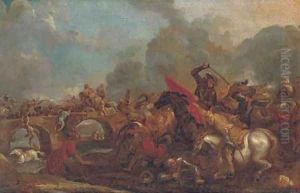Francesco Monti, Il Brescianino Paintings
Francesco Monti, known as Il Brescianino, was an Italian painter of the Baroque period, born in 1683 in Brescia, a city in the Lombardy region of Italy. He should not be confused with Francesco Monti (Brescianino dei Campi), another painter from Brescia who was his contemporary. Monti's epithet 'Il Brescianino' essentially means 'the little one from Brescia,' which helped to distinguish him from other artists with similar names.
Monti's artistic career began in his hometown, where he was initially influenced by the rich artistic environment of Brescia, which had been shaped by the work of earlier Renaissance masters such as Moretto da Brescia and Romanino. Monti's early work was characteristic of the Baroque style, with dramatic use of color and light, dynamic compositions, and a strong sense of movement.
Throughout his career, Monti was known for his religious paintings, frescoes, and altarpieces. He primarily worked for local churches and religious institutions, which were the main patrons of art at the time. His works often featured saints and biblical scenes depicted with emotional intensity and a keen attention to detail.
Monti's style evolved over the course of his life, reflecting the transitions in Baroque art towards the Rococo. His later works displayed a lighter palette, more graceful figures, and a gentler approach to the expression of religious themes. Despite his evolution in style, he remained rooted in the spiritual and devotional purposes of his art, which was a hallmark of the Counter-Reformation period in which he lived.
While Monti may not have achieved the same level of fame as some of his contemporaries, his contributions to the Baroque period in Northern Italy were significant. His paintings can still be found in churches and museums in Brescia and the surrounding regions. Francesco Monti, Il Brescianino, died in 1768, leaving behind a body of work that continues to be appreciated for its devotion and artistry.
